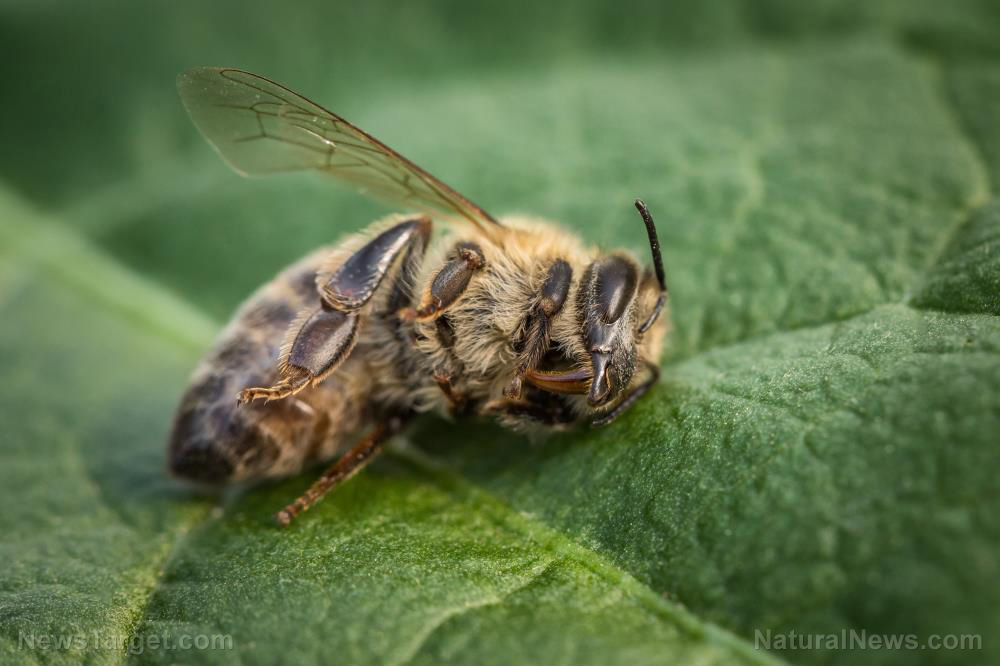Study: Pesticides are highly damaging to beneficial insects like bees
08/24/2022 / By Mary Villareal

Pesticides damage nervous systems of bees in a way that they cannot orient themselves properly after exposure.
Scientists have found that the chemicals sulfoxaflor and imidacloprid, which are commonly sprayed onto plants to kill insects, block signals between nerves and target cells. This proves that pesticides are also highly damaging to beneficial insects like bees.
To give more proof of the dangers of pesticides, researchers from the University of Oxford showed how pesticides could impair bees’ optomotor response, which usually manifests as movements that help insects orient themselves when they are blown off-course while walking or flying.
“Our results are reason for concern because the ability of bees to respond appropriately to visual information is crucial for their flight and navigation, and thus their survival,” said lead author Dr. Rachel H. Parkinson. (Related: Save the bees: The American Bumblebee may become critically endangered, warn researchers.)
In humans, asking a patient to walk up and down in a straight line is a way to diagnose neurological symptoms such as ataxia, where parts of the brain that coordinate movement become impaired.
Scientists used the same technique to probe honeybee foragers’ optomotor responses after they ingest common pesticides.
Sulfoxaflor and imidacloprid typically kill insects by binding to neurotransmitter receptors, thereby blocking chemical signals from being passed between nerve cells and target cells. However, their intensive use has been linked to the worldwide decline in pollinating insects, which are essential for plants and crops to grow.

In the study, which was published in Frontiers in Insect Science, bees were suspended on a tracking ball that registered their walking motion. Four groups of 22 to 28 wild forager honeybees took part in the experiment, and each of them drank a different sucrose solution over five days.
One solution was pure sucrose for control, and the other three were contaminated with either imidacloprid, sulfoxaflor or a mix of both.
Two screens in front of the bees showed videos of black and white vertical bars that moved from left to right and switched right to left to trick the bee into assuming that she has been blown off course and needed to perform a corrective turn to return to a straight path.
The width of the bars and the speed at which they moved were changed during the experiment to alter how far away the stimulus appeared from the bees’ perspective.
Bees that have a functioning optomotor response would be able to re-orient back to an illusionary straight line after the bar movement changed direction.
Bees exposed to pesticides have more dead cells in optic lobes
The researchers found that all the bees were worse at responding to the bars’ movements when they were narrow or moving slowly, thus appearing further away. (Related: Pesticides that kill bees, birds and butterflies found to be ineffective at increasing crop yields.)
However, no matter the bar width and speed, the bees that ingested the pesticides performed poorer than the control group. They would either not turn at all, or turn quickly in one direction and could not alter their course in response to the changing direction of the moving bars.
Moreover, the difference in rotation between left and right turns was at least 2.4 times greater for those exposed to pesticides.
The researchers also studied the brains of the participating bees to probe for any physical effects of exposure and found that sulfoxaflor-exposed bees tended to get a higher proportion of dead cells in parts of their brains’ optic lobes, which are important in processing visual input. This suggests that commonly used insecticides can impair the visually guided behavior of honeybees, according to Parkinson.
They also hypothesized that the observed effects on the bees’ optomotor responses could be the result of their brains re-wiring themselves following the detection of the insecticides.
As toxic chemicals activate the neurons inside the brains of the bees, they could also be reducing their sensitivity to them. This could prevent further brain damage inflicted by the insecticides before the body can naturally recycle them.
Parkinson noted that there is a need to explore whether the effects observed in walking bees also occur in free-flying ones. “The major concern is that – if bees are unable to overcome any impairment while flying – there could be profound negative effects on their ability to forage, navigate, and pollinate wildflowers and crops,” she said.
Visit Bees.news for more news related to bees.
Watch the video below to know more about the importance of bees in the ecosystem.
This video is from the Natural News channel on Brighteon.com.
More related stories:
New research shows why flower diversity is important for bee conservation.
Pesticide cocktails found to be more dangerous to bees than expected.
Bee aware: About 75% of the world’s food crops rely on bees and other pollinators.
Deadly pesticides STILL in use: Neonics are killing bees and birds, warn researchers.
Bees live shorter, become sicker because of air pollution, scientists find.
Sources include:
Submit a correction >>
Tagged Under:
This article may contain statements that reflect the opinion of the author




















